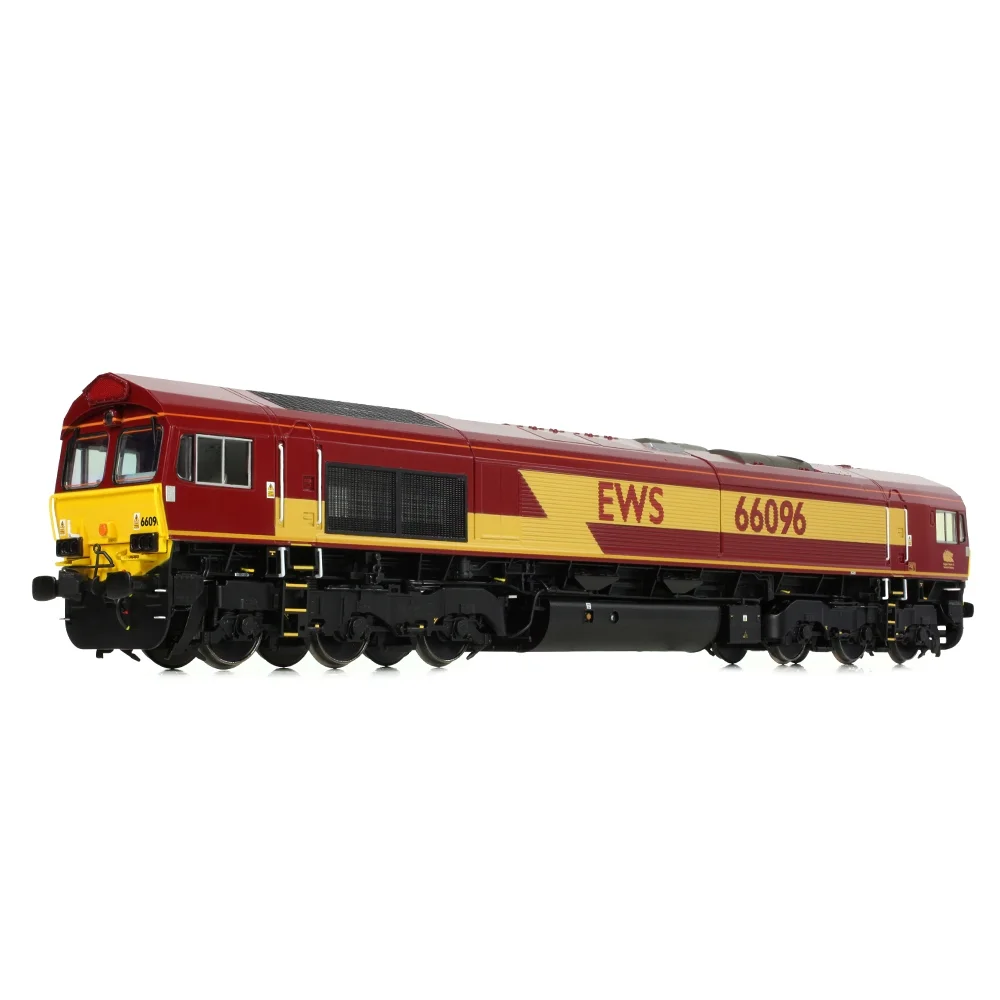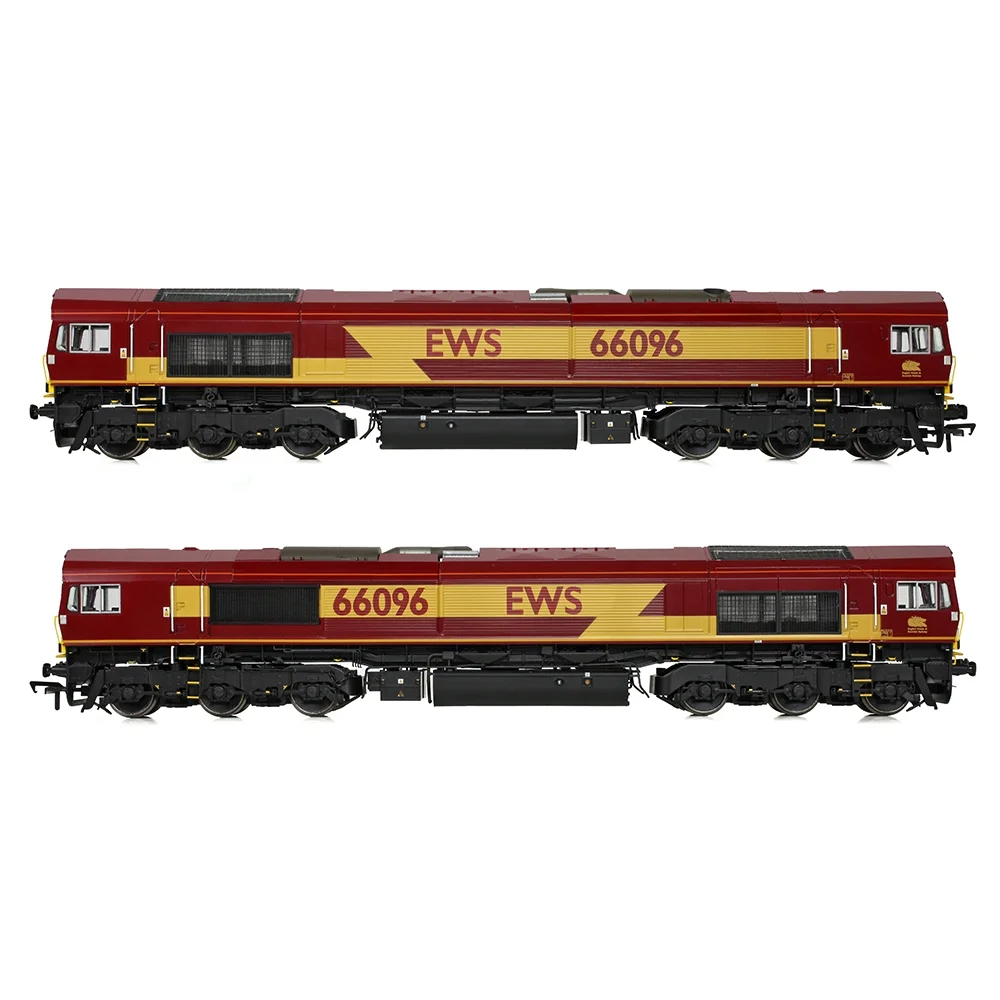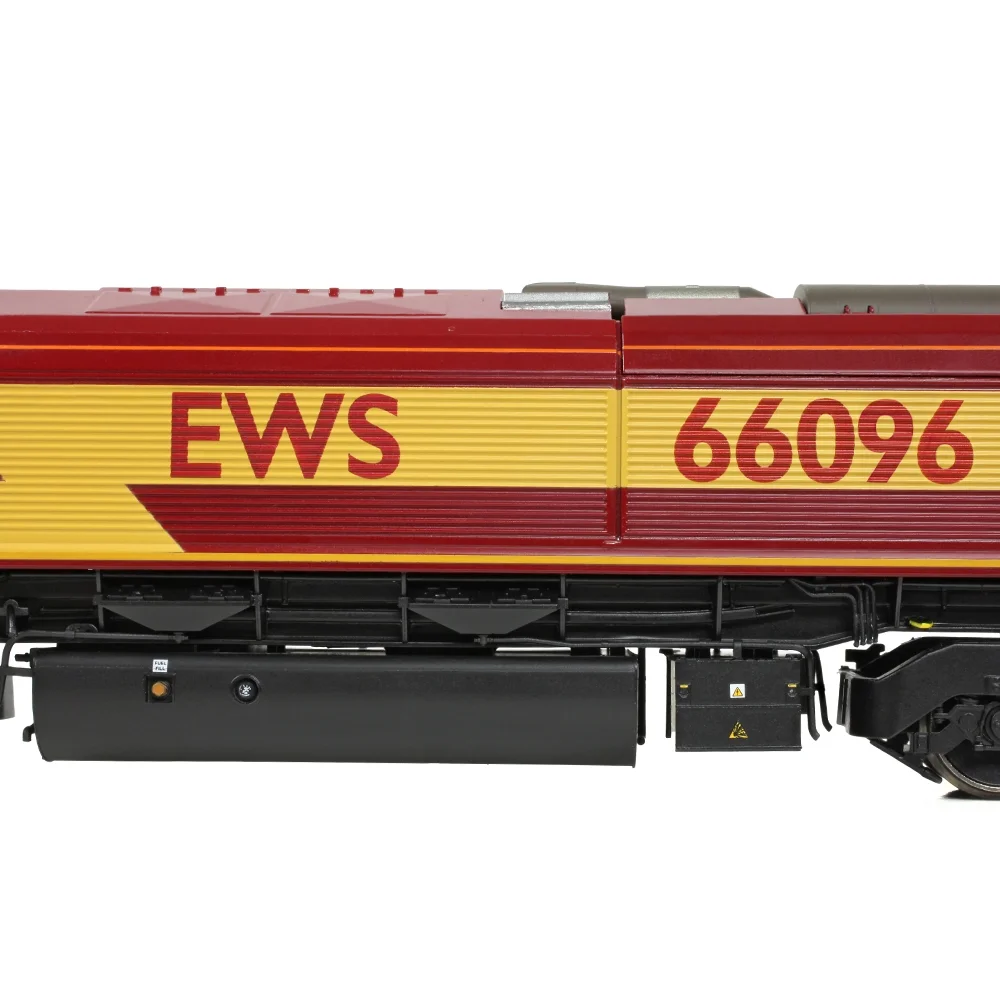Bachmann 50-000ASFX
British Rail Class 66/0 66096 English, Welsh & Scottish Railway Maroon & Gold
Bachmann's Description & Specifications
The Class 66 Diesel Locomotive revolutionised the British rail freight landscape when the first examples arrived in 1998, and more than a quarter of a century later, the type remains at the forefront of freight operations the length and breadth of the country. Now, we are delighted to present the all-new Bachmann Branchline OO Scale Class 66 which has been designed from the rails up, capturing this modern icon like never before.
The new Class 66 combines a high-fidelity, injection-moulded bodyshell with a heavy, diecast chassis to which separate main frames are fitted. A multitude of individual parts are then added, manufactured in both metal and plastic, to capture every element of the prototype. The HTCR radial bogies are reproduced in miniature using multiple components, with many separately added details, resulting in these true to life replicas which interface neatly with the locomotive’s frames for an authentic appearance and accurate ride height. The separate axle heads that each rotate smoothly and reliably when the model is moving, mimicking this characteristic feature of the prototype, is the finishing touch.
The colourful liveries of modern operators present some challenges when it comes to decorating our models, but with extensive research, close collaboration with the operators themselves and decades of experience producing beautifully finished models, we are able to replicate every detail. Paintwork is applied with a rich, uniform finish using original specification colours, which is then adorned with logos, typefaces and graphics, all reproduced authentically using multi-stage printing techniques to produce a model with the finest of looks.
Meanwhile, ‘under the bonnet’ the new Class 66 boasts a high specification that utilises the latest advancements in model railway technology. A full lighting suite includes directional lights, with day and night mode and stabling mode, along with cab lights and machine room lights, all of which can be controlled to full effect when the model is used on DCC. To fit a DCC decoder, it’s simply a case of removing the magnetic roof panel and swapping out the blanking plate for a Plux22 decoder. DCC users also benefit from the integrated Bach-Up Stay Alive System which provides uninterrupted power to prevent stalling, light flicker and, for those fitting sound to their model, sound cut-outs. Already using DCC? Then why not opt for one of our SOUND FITTED models instead and start enjoying authentic sounds, a full complement of lights and the Bach-Up Stay Alive System straight out of the box!
- Bachmann Branchline OO Scale
- Era 9
- Pristine EWS livery
- Running No. 66096
- SOUND FITTED DELUXE – Fitted with a ESU Loksound V5DCC Sound Decoder
- Auto-Release Coupling System (Fitted at both ends)
- Length 282mm
DETAIL VARIATIONS SPECIFIC TO THIS MODEL
- Original 4-Door Locomotive
- 3-Piece Cab Side Windows with Separate Quarterlights
- Original WIPAC Light Clusters (3-Lamps)
- Small Top Light Box
- Standard UK Pattern Buffers
- Combination Drawgear with Buckeye Couplings
- Standard Horn Box
- NRN Radio Pod on Roof
- 4 Cab Vents
- 2 Securing Lugs at each End
- Cab Front Handrails with 5 Mounting Points
- Cab Interiors with Pedestal Control Panels
- Original Sandboxes
- Angled Sandpipe Brackets
- Smooth Bogie Lifeguards
- Cab Front Steps
BACHMANN BRANCHLINE CLASS 66 SPECIFICATION
MECHANISM:
- Five pole, twin shaft motor with two flywheels providing drive to both bogies
- All axle drive
- Electrical pickup from all wheels
- Separate metal bearings fitted to each axle
- Diecast metal chassis block and bogie towers
- Diecast metal gearboxes, with gearing arranged for prototypical running speeds and haulage capabilities
- 5mm (OO gauge) wheels to NEM310 & NEM311 standards with authentic profile and detailing
- Close coupling mechanism fitted at each end, each of which is fitted with coupling pockets to NEM362 standards
- Auto-Release Couplings fitted at both ends – DCC operated, hands-free uncoupling with the press of a function button (SOUND FITTED DELUXE models only)
- Designed to operate on curves of second radius (438mm) or greater
DETAILING:
- Precision moulded bodyshell and locomotive main frames, with numerous separately fitted parts including horn boxes, fuel tanks, battery boxes and sand boxes
- Separately applied metal detail parts, including cab-front steps, securing lugs, lifting points, lamp brackets, and cab door handrails
- Individual pipe and cable runs added to the main frames, underframe and bogies
- Bogies constructed from multiple components featuring full relief detail
- Separately fitted axle heads on each wheel which rotate smoothly and authentically when the model is moving
- Close-fitting bogie to main frame interface providing an authentic appearance and accurate ride height
- Etched roof, bodyside and horn grilles, with multi-part bodyside cooler group grilles and multi-layered internal partitions providing visibility through the full width of the locomotive
- Sprung metal buffers
- Cab interior detailing which includes the control desk, cab seats, hotplate and rear partitioning and doors, complete with extensive interior decoration
- Alternative front valances with/without coupling cut-outs – interchangeable by removing two screws and without the need for body removal
- Each model supplied with a full set of decorated, model-specific bufferbeam pipework and accessory parts
LIGHTING:
- Directional lighting, switchable on/off at either end on DCC or Analogue control
- Day/Night mode, selectable on DCC or Analogue control
- Directional lights and Day/Night Mode selection is controlled via easy-access switches on the roof when operated on Analogue control
- Stabling lights mode* (red tail lights only, displayed at both ends)
- Cab lighting*, assigned to two DCC functions for separate switching of each
- Separately switched Machine Room lighting* (*when used on DCC)
- Authentic light colours and temperatures selected for each model based on era and application
DCC:
- Plux22 DCC decoder interface
- Easy-access DCC decoder socket via a removable roof panel – magnetically secured
- Bach-Up Stay Alive System providing uninterrupted power to prevent stalling, light flicker and sound cut-outs (operates on DCC only)
SOUND:
- Speaker Fitted – a pre-fitted speaker is included with every model as standard
- Dual Fitted XL Speaker System – SOUND FITTED and SOUND FITTED DELUXE models feature two speakers, including our new speaker with enhanced bass reproduction – a patented component which incorporates a passive radiator design for optimum sound performance
- ESU Loksound V5DCC Sound Decoder fitted to SOUND FITTED and SOUND FITTED DELUXE versions
- Sound files produced specifically for the Bachmann Branchline Class 66 using recordings from real locomotives
- SOUND FITTED and SOUND FITTED DELUXE models operate on DCC and Analogue control as supplied. On Analogue, an authentic engine start up sequence and running sounds are produced when power is applied
LIVERY APPLICATION:
- Authentic liveries applied to all models
- Multiple paint applications employed on each model using original specification colours
- Logos, numerals and text added as appropriate using multi-stage tampo printing using authentic typefaces, logos and colours
Class & Prototype
- Class: British Rail Class 66/0
- Traction: Diesel
- Transmission: Electric
- Built: 1998-2000
- Total Built: -
The British Rail Class 66, introduced in 1998, revolutionized UK freight operations with American EMD reliability. Built as the JT42CWR model with a 12-cylinder 710 engine producing 3,300 horsepower, these Co-Co diesels achieved 95% availability versus 65% for the Class 47s they replaced. Approximately 412 locomotives remain operational across DB Cargo UK, GB Railfreight, Freightliner, DRS and Colas Rail, dominating intermodal container services, aggregates, steel, biomass and infrastructure traffic. The class's 27-year production run ended in 2016 with 66779 "Evening Star" due to EU emissions regulations. No replacements are expected before the 2040s, ensuring continued prototype relevance. The Class 66 offers modellers exceptional livery diversity across all major operators, making it essential for any British layout from 1998 onwards.
No prototype found.
Operator & Livery
- Operator: English, Welsh & Scottish Railway
- Livery: Maroon & Gold
The English, Welsh & Scottish Railway (EWS) operated Britain's largest rail freight network from 1996-2007, controlling 90% of the UK freight market. Formed by Wisconsin Central through acquisition of five British Rail freight companies, EWS revolutionised British freight transport with 250 new General Motors Class 66 locomotives and distinctive maroon and gold livery featuring the famous "three beasties" logo. The company was acquired by Deutsche Bahn in 2007, eventually becoming today's DB Cargo UK while maintaining its freight market dominance.
The EWS maroon and gold livery was introduced in April 1996, with the first locomotive to receive the scheme being Class 37 number 37057, which emerged from Toton Depot on 25 April 1996 to coincide with the launch of the English, Welsh & Scottish brand. The colour specification featured maroon bodysides, roofs and ends with black underframes and buffer beams, standard UK yellow warning panels, and a distinctive gold stripe running centrally between the cab ends.
To ensure accurate colour consistency, a sample plate was flown from Wisconsin Central's American operations to Britain, where British paints were mixed to match this standard. Interestingly, when Class 66 and 67 locomotives were later built by General Motors, another sample plate was sent to the manufacturer, resulting in a slightly lighter shade than the original British mix.
The livery evolved through several variations. Early applications from April 1996 featured "EW&S" lettering (including the ampersand) in Arial typeface within the gold band. From January 1997, this was simplified to "EWS" with improved Gill Sans typeface - continuing a tradition established by the LNER in the 1920s and used by British Railways until the 1960s.
The gold band width varied by locomotive class - most received 600mm bands, but Classes 37, 58, and 73 looked better with 550mm bands due to their distinctive body shapes. Company lettering and locomotive numbers appeared in maroon within the gold stripe with 20mm clearance from the band edges, positioned at opposite ends on each side of the locomotive.
For model railway enthusiasts, specialist paint manufacturers like Phoenix Paints produce authentic colour matches, with their E.W.&S. Red (P193) and E.W.&S. Gold (P194) paints matched to original Wisconsin Central colour panels. Alternative options include RailMatch EWS Maroon (1255) which many modellers prefer for value and colour accuracy.
The EWS maroon and gold scheme became one of the most recognisable railway liveries in modern British history, remaining in use until Deutsche Bahn's acquisition in 2007 and the subsequent adoption of DB Schenker corporate red livery from 2009.




